
Sally Anscombe/Getty Images
- An infected cut can cause red skin, oozing pus, and a yellow crust around the wound.
- You may be more likely to get an infection if you have diabetes or an immune system disorder.
- You should see a doctor immediately if you are experiencing fever, chills, or worsening pain.
- Visit Insider's Health Reference library for more advice.
Most minor cuts heal on their own within about two weeks. But if your cut grows increasingly redder and more swollen after a few days, this may be a sign that it's infected.
In many cases, you can treat an infected cut at home with antibacterial ointment and bandages, but for more serious infections, you may need to see your doctor.
Here's how you can tell if your cut is infected and how to treat it.
When to see a doctor
If you think your cut is infected, it's best to reach out to your doctor, says Alana Biggers, MD, a professor of medicine at the University of Illinois at Chicago.
"You should see a doctor immediately if you are experiencing fevers, chills, or you are experiencing a lot of pain that is worsening," says Biggers. This could be a sign that the infection is spreading or getting worse. If left untreated, the infection could spread to your blood and other parts of your body.
Depending on your injury, your doctor may decide to prescribe you oral antibiotics.
How to care for an infected cut
To prevent the infection from worsening, it's important to keep your cut clean. Biggers suggests following these steps to clean and care for an infected cut:
- Wash the area around the cut with warm water and soap, avoiding the actual cut to prevent irritation.
- Gently pat it dry as moisture can worsen the infection, Biggers says.
- Apply an over-the-counter antibiotic ointment like Neosporin or Polysporin to the area.
- Cover the cut with a bandage or gauze that fits the size of your wound
How to prevent infected cuts
To prevent your cut from becoming infected, wash it right away with water to remove any dirt or debris that may lead to infection. Sometimes you may need to pull debris with tweezers.
Insider's takeaway
If you get a cut, you should clean it right away to prevent an infection. Small, minor cuts may not need much treatment, but for bigger cuts, you need to keep the area clean using an antibiotic ointment and cover the cut with gauze.
If the cut looks infected with signs like redness, odor, or pain, contact your doctor to see if you need further treatment.
"If you are experiencing fevers, chills, or severe pain around the cut, then you should seek medical attention right away and not wait for an appointment," says Biggers.
